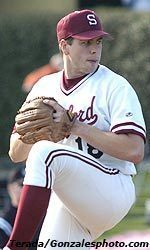April 9, 2005
| Jeff Gilmore |
 |
| Sport: Baseball |
At first glance, Jeff Gilmore's success at Stanford might seem to defy logic. Without an overpowering fastball, the junior right-hander has posted a 15-3 career record and a 3.90 ERA due mostly to his ability to throw an assortment of pitches in a variety of counts to all parts of the plate.
But a conversation with Gilmore reveals much more - or less - than that. His formula for success is actually based on some simple logic.
"There's good sense in getting the first strike on a hitter or the first batter of an inning out," Gilmore uses as an example. "Every advantage you get, it's going to make it that much harder for the hitter to get a pitch he likes. It's going to make it that much harder for a coach to create offense."
Simple, but profound. There's more.
Gilmore described a recent conversation among the team's pitching staff about who pitched to "the glove" and who pitched to "the hitter".
"Through their competitiveness, most of the guys on our staff said that they pitched to the hitter," recalls Gilmore. "I was one of the few that claimed to pitch to the glove."
"There's nothing else going on for me when I pitch except focusing on the catcher's glove," continues Gilmore, who claims to rely on scouting reports a little less than other pitchers. "My thought is that I'll take a well-executed pitch over a great scouting report that can't be executed. I tend to pitch more to my strengths and less to hitters' weaknesses."
Gilmore's strengths are his precision and the ability to throw four pitches for a strike at any time in the count, while keeping opponents off the bases. He has allowed an average of just 2.16 walks per nine innings in his Stanford career and struck out three times as many batters (120) as he has walked (40). Last year, he was able to post a 10-2 record despite allowing a moderate .257 opponents' batting average.
"I think a walk is the same thing as a hit," simplifies Gilmore.
To explain his point, he uses another logical example.
"If the count is 3-1 on a batter, I am thinking `strike, strike, strike'," offers Gilmore. "Even if he hits .500 in that situation, I'm a lot better off throwing a strike than a ball, which means that he gets on base 100% of the time."
Simple, but true.
Gilmore illustrates another situation that makes a lot of sense that he picked up from Stanford's fall intra-squad games when all counts start with one ball and one strike on the hitters.
"Our hitters hate it when the count starts at 1-1, because you can throw one good pitch and they are already down in the count 1-2," says Gilmore. "Every time I get a hitter into that situation in a game, I think about that."
It's that type of simple logic that helps make him that much more effective.
He also took a very logical approach during his freshman campaign.
"My season was effectively over by this point in the year as a freshman and that allowed me to experiment with different pitches and try new things," remembers Gilmore. "My focus immediately became what I considered to be my next step in order to have success at Stanford."
That next step was a summer stint with the Mat-Su Miners of the Alaska Baseball League. Summer baseball tends to be most important for players that don't get much of an opportunity to showcase their stuff during the regular collegiate season and Gilmore fit right into that case. With a fresh arm (he pitched just 2.1 innings as a freshman at Stanford in 2003) and the new knowledge that he had gained by experimenting with pitches during the spring at Stanford, Gilmore turned heads by posting a 1.41 ERA in 32.0 innings of work mostly out of the bullpen.
With three of four starting pitchers from Stanford's 2003 College World Series team moving on to the professional ranks and his surprising summer campaign in the books, Gilmore was all of a sudden a candidate to get a lot of work on the hill.
Five innings of scoreless relief and a save during two outings in the team's first series of the year versus eventual 2004 College World Series champ Cal State Fullerton earned him his first start versus Fresno State the following week. He has been in the Cardinal rotation ever since, eventually settling into the No. 2 spot behind Cardinal ace Mark Romanczuk.
Gilmore and Romanczuk offer a set of contrasting styles that seem to compliment each other well.
"We are two different types of pitchers," confirms Gilmore about his teammate, who he claims abhors giving up hits but is known to need his best stuff to work his way out of jams often caused by his own doing.
"Despite our differences in styles and approach, we are basically the same competitor," he continues. "It doesn't really matter which school of thought you have, as long as you believe in the one you are using."
Pretty smart, pretty simple.
by Kyle McRae